
A Fight for Recognition: making Portrait of a Whistleblower
by JESSIE BOYLAN
- View Jessie Boylan's Biography
Jessie Boylan is a photomedia artist based in Chewton, Victoria, and a lecturer in Photography at La Trobe University in Bendigo, Australia.
A Fight for Recognition: making Portrait of a Whistleblower
Jessie Boylan
Introduction
In the years between 2014 and 2018, I interviewed Avon Hudson many times at his home in Balaklava -- about an hour and a half north of Adelaide. Sometimes I spoke with him by phone, but more often I'd stay there, in his sprawling old house, memorabilia all around. In 2014 Avon and I began to compile Portrait of a Whistleblower, first exhibited at the Balaklava Courthouse Gallery in 2015 as part of Adelaide's Fringe Festival. The concept developed during a residency at Avon's for the Nuclear Futures community arts program; and my collaborators were Ellise Barkley (Program Manager), Paul Brown (Creative Producer), Avon and his daughter Kate.1
There are several kinds of material in this paper: Extracts and paraphrasing from my interviews with Avon; my reflections on the creative process; images from Portrait of a Whistleblower; and samples of the catalogue text that accompanies the exhibition.
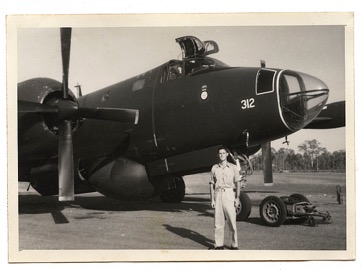
Figure 1) Avon Hudson in front of Lockheed Neptune aircraft, Darwin Airbase, Est. 1958.
Starting point
On the afternoon of Thursday December 2nd, 1976, ex-Royal Australian Air Force serviceman Avon "Rock" Hudson arrived home from work in Adelaide and answered the telephone, which had been ringing all day in his absence. It was a producer from This Day Tonight, an Australian Broadcasting Commission (ABC) current affairs program filmed from Adelaide, South Australia. They told Avon to get in his car and drive back to Adelaide right away because they wanted to interview him on that evening's program. As Avon sped down the highway at 150 km an hour, it occurred to him that what he was about to do could damage his life forever. "Bugger it," he thought, "It'll be the end of me anyhow if I don't do it." What he knew and had kept secret had plagued him since 1960, and was having a detrimental effect on his day to day life. At the studio, the producer was waiting and rushed him inside: "I had to run down the corridor and was ushered into a waiting room, adjacent to the theatre," he told me during an interview in 2016, "I was only there for two or three minutes, a lady came in and put some make up on my face and said "you must be looking your best," which I wasn't at all concerned about, but half way through, the producer came in and said "drop that, you're on.""
Avon, 39 at the time, was about to break the law and risk seven years' imprisonment -- a violation of the Official Secrecy Act.2 He walked onto the TV set and sat down opposite his host Clive Hale. It was a Friday night and back at home Avon's wife and two daughters were watching the television in anticipation of what he was about to do. Avon began to speak of what he witnessed at Maralinga and about the buried plutonium that still remained on site. The segment lasted four minutes and twenty-six seconds, and in that time Avon exposed the fact that plutonium had been blown to pieces at Maralinga, 1200 kilometres north-west of Adelaide, South Australia, and that "pieces as big as your thumb," remained at the Taranaki test site. Avon knew that if he hadn't done it then, probably no one else would ever have blown the whistle.
"Plutonium is forever, it never goes away," he recently said to me over the phone. "It was the moral question, what if I didn't do it, rather than what if I do, you've got to think of the future, not me, not you, it's everybody who's going to pay the penalty."
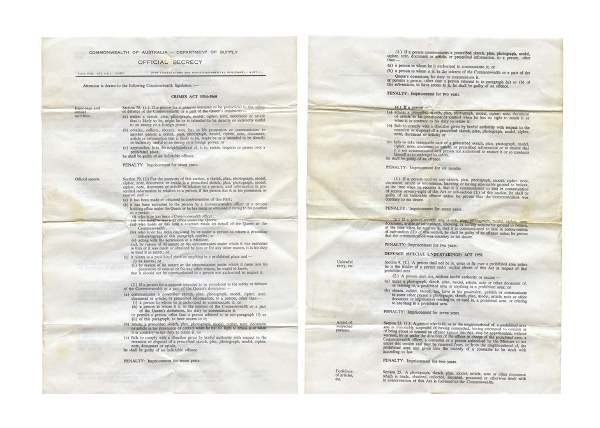
Figure 2) Official Secrecy, Crimes Act, 1914-1960. Reproduction from an original document. Digital inkjet print; 25 x 35 cm. Avon Hudson's private collection. All servicemen were forced to sign this before being posted to Maralinga. Photo: the Author.
In the lead up to the This Day Tonight segment, Avon had heard that the Australian Government was planning to give the land back to the traditional Aboriginal owners and he felt that he had to speak up about how contaminated it was after the partial cleanup of Maralinga and Emu field in 1964.
Avon had intended to blow the whistle earlier, after he started seeing his friends dying in their thirties and forties. "...When you'd ask where's Bill or where's Bob, "Oh he'd be dead," Avon said to me over the phone, but he was agonizing over the impact it would have on him and his family. "You've got to remember I had two young kids at the time and I had to think about what would happen if I was to go to jail for a very long time. I had to seek some very serious legal advice," he said.
Meeting Avon
I first met Avon in 2005 on an environmental tour of the South Australian nuclear industry run by Friends of the Earth Melbourne3. Avon was a guest on the trip, speaking about his experience at Maralinga and the Woomera Test Range, as well as his lifetime of struggle for recognition as a nuclear veteran and advocacy for Aboriginal people and other veterans impacted by the atomic tests at Maralinga.
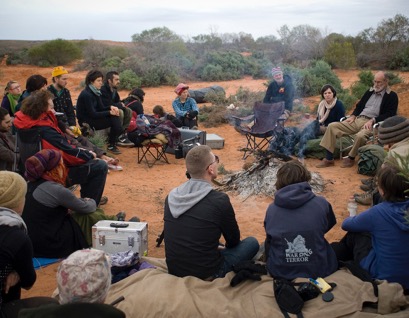
Figure 3) Listening to Avon, Radioactive Exposure Tour, 2010, Woomera, South Australia. Digital inkjet print; 23 x 18 cm. Photo: the Author.
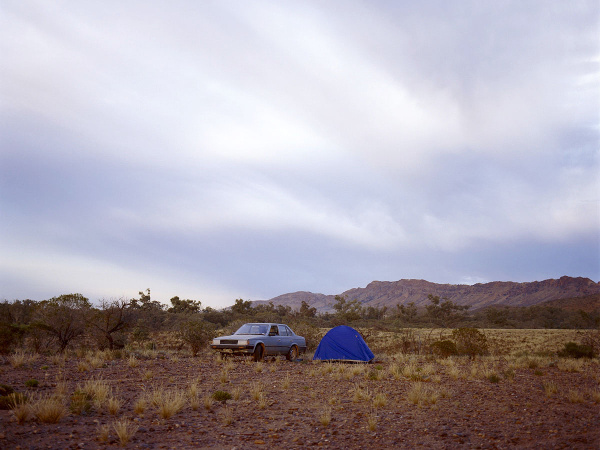
Figure 4) Avon's Camp, 2010, Gammon Ranges, South Australia. Digital inkjet print; 30 x 40 cm. Photo: the Author.
I took many photographs of Avon on that trip, and the following year I made a more formal portrait of him at the Woomera Missile Park which was to be a part of an exhibition I was making titled 'Inhabited' in 2006.4
I photographed those tours each of the six times I attended5; the campsites, meetings, mine tours and actions; and Avon returned to the tours year after year, maintaining his advocacy through education and first-person storytelling. Members of the Anti-nuclear and Clean Energy Collective at Friends of the Earth, of which I was a part, all knew and thought that Avon was a living treasure, yet weren't sure how to acknowledge this publicly. It wasn't until 2014 that an exhibition to formally recognise Avon's life and life's work came about through the Nuclear Futures Project.
Making Portrait of a Whistleblower
"I had a relatively normal life," Avon said from his home in Balaklava, a rural farming town one-hour north of the South Australian capital, Adelaide. "Well, it was not quite as normal as most people's, but after Maralinga, it all changed. I was just one of the tens of thousands, then I got caught up in a particular thing, that most of the rest didn't, that changed everything, it changed life itself."
Too often we only celebrate a person's life once they have passed away. Making the exhibition Portrait of a Whistleblower was an attempt to honour Avon's life and life's work as whistleblower and activist while he is still alive, a way of giving recognition to someone who has spent most of his life fighting for it. It was envisaged that the exhibition might also be a means to acknowledge and celebrate Avon's extraordinary life within his community - to shed light on and pay homage to his experiences, dedication and achievements. While Avon was well known in the Wakefield district in South Australia, having served on the local Wakefield Council for 20 years, a local disconnect was evident, and Avon (despite growing up in the area) considered himself as somewhat of an outsider, often marginalised for his politics, which were considered radical.
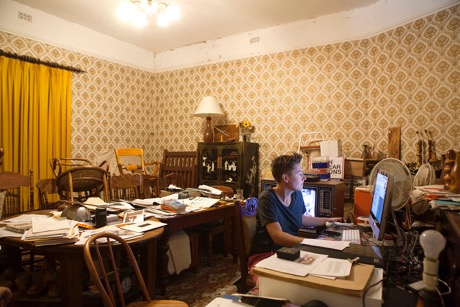
Figure 5) The Author working on Portrait of a Whistleblower in Avon's room of archives, Balaklava, South Australia, 2015. Photo: the Author.
Contextualising and summarising a life's work
"You can't erase some things from your head," said Avon, "once you've seen something, what you've been involved in, you can't erase that from your head. Once you've seen what nuclear weapons can do, you do everything to stop them from being used again."
In order to achieve any kind of tangible recognition for Avon and his life's work the Nuclear Futures team had the mammoth task of rummaging through the plethora of objects, documents and artefacts while Avon himself was alongside us, narrating the story behind each item. Meticulously, we culled the material down to a comprehensible, understandable story. We decided to use the simple method of time and work chronologically, separating each section of his life into chapters, that would be visually laid out as such. The work had to speak to Avon's life, and ensure that enough, but not too much, was being said about it, to not overwhelm the viewer, yet include enough so the complexities and richness of his story would come across.

Figure 6) Portrait of a Whistleblower at The Block, Queensland University of Technology, Brisbane, 2015. Photo: the Author.
One of the biggest fears for Avon, was that he would be forgotten or ignored, this fear has turned to anger and deep sadness as he felt his actions will have been for nothing. "It changed my whole life," he said, "looking back now, to a very large degree, I've been used, and a lot of other people have gotten the credit and done well out of it; and I haven't."
Avon feels as if he has given his life to this issue, and although he wouldn't change his decision to blow the whistle, that he is the one who suffered with no positive regard, while others benefited from his actions. "I prevented the land from being handed back for a number of years," he said, "if I hadn't done it they may never have had that clean-up. There's rewards in it, there's kicks in the guts. One of the biggest reward I've outlived some of my enemies, like Fraser."
Portrait of a Whistleblower is a story about a young RAAF serviceman turned whistleblower, who once had a love and belief in his country, who served his country and went where he was told to go, yet when he started to see his mates dying young, he knew he had been lied to.
"It's the total injustice really," he says from his chair at the end of the dining table, neatly positioned toward the television, newspaper used as a dinner plate, head cocked to one side, "when you lose faith in the government, in the people who are supposed to be taking care of you, and be responsible, they were the least responsible, really."
While Avon hoped for recognition for his sacrifices, like a veteran's Gold Card6, financial compensation to live a better life, or a more formal acknowledgement of his actions in Australian historical records, this exhibition was a form of recognition that he needed. Avon could see his own life and his achievements laid out in front of him, he could see others seeing it too, he could talk with people about the stories in each image and object, and he could walk away knowing that his story had been told.
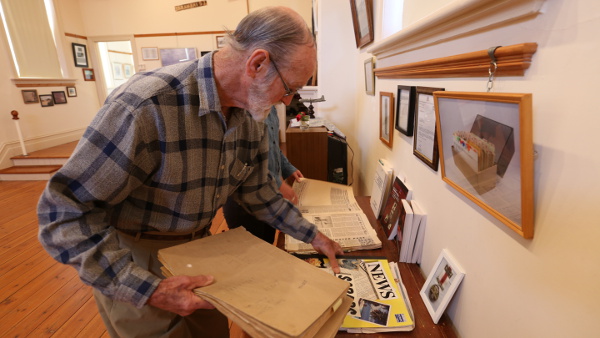
Figure 7) Avon Hudson with his scrapbooks: Installation of Portrait of a Whistleblower at Courthouse Gallery, Balaklava, South Australia, 2015. Photo: Tania Safi.
Exhibition Images and Wall Text
The second half of this paper presents a selection of images from Portrait of a Whistleblower, and samples of the wall text and captions that accompany the exhibition.
Exhibition Wall Text: "Introduction"
This series chronicles Avon Hudson's life, from early years growing up in regional South Australia, to service in the Royal Australian Air Force as a Leading Aircraftman, through the experience of British atomic bomb tests, to his "whistleblower" act of revealing Maralinga's deadly legacy.
What Avon knew, and was prepared to tell publicly about Maralinga, contributed to the establishment of the Royal Commission into British Nuclear Tests in Australia (1984-85). His motivation was to put a halt to government plans to return Maralinga to its traditional owners, pending a full clean-up of land still contaminated by radioactive debris.
The story of nuclear testing is unknown to most Australians. Between 1952 and 1963, after a decision made by Prime Minister Menzies alone, nine atomic bombs were exploded and hundreds of 'minor' experiments were conducted at the British-run testing ranges at Emu and Maralinga in South Australia. Three bombs were also exploded at Monte Bello Islands in Western Australia.
The impacts of these experiments continue to play out in the ill health and changed lives of both Aboriginal and non-Aboriginal communities, who were exposed to or involved in the tests, over multiple generations. The tests have also left a deep-future legacy of environmental contamination.
This exhibition is curated from the treasure trove that is Avon's own extensive collection of documents, news clippings, photographs, objects and artifacts, that make up his life's work. These are combined with contemporary photographs and video works by photo-media artist Jessie Boylan, who has worked and travelled alongside Avon over the past ten years on numerous anti-nuclear and educational journeys.
It is a portrait of someone with a photographic memory, capable of grasping and articulating every detail of the atomic age as he experienced it.
It depicts a committed citizen and serviceman, husband and father, always an advocate and an activist, who in civilian life became a Wakefield councilor for over 20 years. It shows a practical man -- mechanic, wood-turner and furniture maker; and portrays a nature-enthusiast and an educator on environmental and social issues.
It is also a portrait of someone who has invariably lived by his convictions -- as that's what whistleblowers do. Since the 1970s, Avon has campaigned for recognition of nuclear veterans and civilian personnel. As his co-authored book Beyond Belief records, "His life has been deeply affected by a sense of injustice and by the callousness of successive Australian and British governments ignoring the plight of those caught up in 'the grand game'."
This exhibition is a recognition and celebration of the significant role Avon has played in South Australia's unfolding atomic history. His life as an activist seems to belong to the present, as the future of nuclear science and technology is considered anew. (Wall Text)
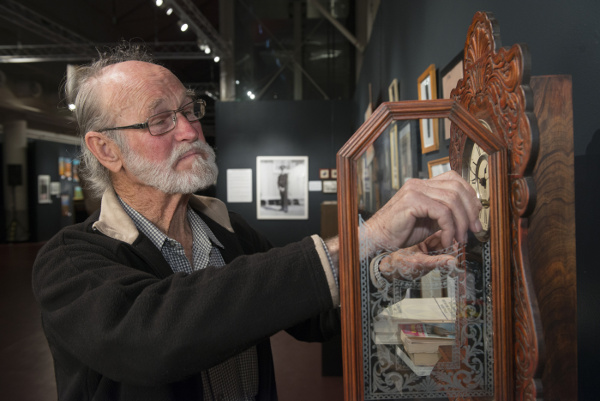
Figure 8) Avon Hudson Portrait of a Whistleblower in Nuclear exhibition at Tandanya National Aboriginal Cultural Institute, Adelaide, South Australia, 2016. Photo: Ben Searcy.
'Early Years'
Avon J. Hudson was born in 1937 at the Balaklava Hospital in regional South Australia. He grew up with six brothers and four sisters on the 'old Hudson's workers blocks', a 54-acre property in Whitwarta, just outside of Balaklava. His father worked as a contractor on the roads, as well as at the salt works in nearby Lochiel, and later got into farming.
Avon's earliest memories are of the immense freedom he and his siblings had on the property, running amok and getting into mischief, "those were the good days, when we were out of the eyes of anybody and close to nature," he says. During the war when life was tough for everyone and food was rationed, the Hudson family grew plenty of fruit and vegetables, and combined with a diet of chickens, rabbits and pigeons, they had most of what they needed to get by. (Wall Text)
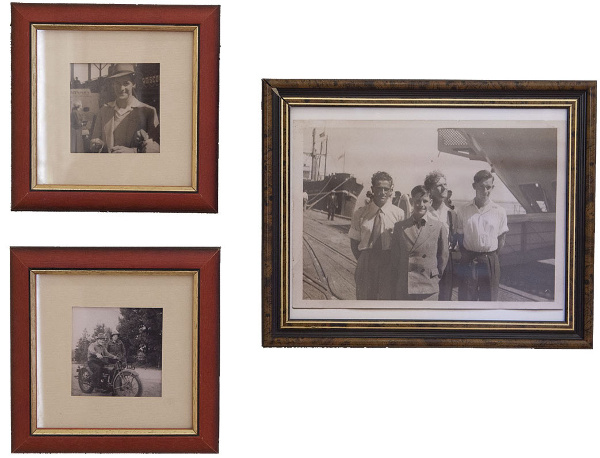
Figure 9) 'Early Years' section Images and Captions: 1. Avon at Balaklava Show, Est.1953, 2. Avon Hudson on 1920s Indian pup motorbike with Trevor Higgs, Est. 1954, 3. Visiting HMAS Sydney, 1952. Photo: the Author.
'RAAF and Service'
Avon was enlisted to the Royal Australian Air Force (RAAF) in 1956 at age 18, and has always had a love of planes, knowing exactly which type of plane is flying overhead just by hearing the sound of its engine. He spent time at the Darwin Air Force Base in the Northern Territory, as well as Laverton in Victoria. Avon served in the RAAF between 1956-62. (Wall Text)
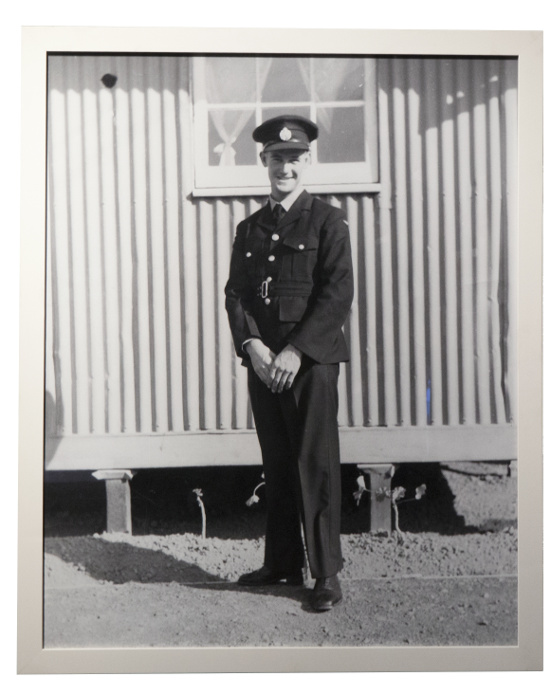
Figure 10) 'RAAF and Service' section: Portrait of Avon Hudson, 1957, Photographer unknown, Laverton, Victoria. Reproduction from an original silver gelatin photograph, Digital inkjet print; 100 x 80 cm. Avon Hudson's private collection. Photo: the Author.
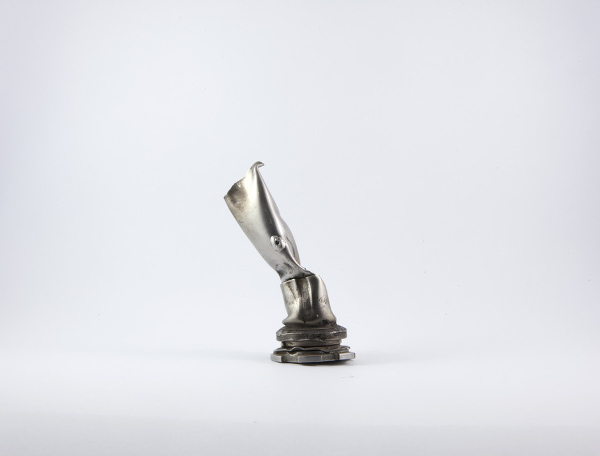
Figure 11) 'RAAF and Service' section: Blue Steel, 2015, Balaklava, South Australia, Digital inkjet print; 50 x 38 cm. This is piece of rocket engine powering the Blue Steel missile as part of weapons testing program at Woomera, South Australia. Avon was a driver at the Woomera rocket range for two years between 1962-64. Photo: the Author.
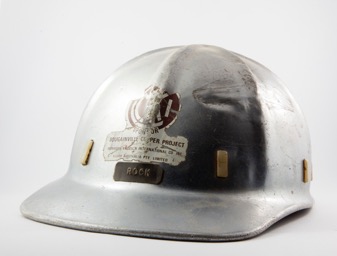
Figure 12) 'RAAF and Service' section: Rock's Helmet, 2015, Balaklava, South Australia. Digital inkjet print; 50 x 38 cm. This helmet was issued to Avon when he began work at the Tidbinbilla tracking station in 1964 and it travelled with him everywhere, including Bougainville, Papua New Guinea. Photo: the Author.
'Maralinga'
In 1960 Avon was posted to Maralinga in South Australia as a mechanical transport driver. He was sent with a team of British engineers to construct the 'Feather Beds', which were the firing platforms on which the Vixen B Minor Trials were conducted on the ground zero site of 'Taranaki', the last of the major atomic bomb tests at Maralinga.
It was because of the Maralinga experiences that Avon chose to not to re-enlist in the RAAF after his six-year term.
Between 1952 and 1963 the British Government performed nuclear weapons tests at Maralinga and Emu Field in South Australia and Monte Bello Islands off the coast of Western Australia. A total of twelve major nuclear tests were performed, and up to 700 minor 'dirty' trials were also conducted. Many Aboriginal people and nuclear veterans have either died or are still suffering the physical and psychological effects of these tests.
The Maralinga village, located over 1000km northwest of Adelaide in remote South Australia, hosted over 8,000 Australian servicemen and 22,000 British, over the entire eleven years the project was underway. The village contained an airport, photography lab, bar, swimming pool, tennis court, football field, cricket pitch and cinema; not many of these structures are left today, but what does remain is mostly overgrown, crumbling or used as a pit for radioactive materials.
The first of the major test series at Maralinga was codenamed Operation Buffalo; it consisted of exploding four nuclear bombs, the first named One Tree was 12.9 kilotons equivalent. The fallout was found as far away as the Northern Territory, New South Wales and Queensland; these tests were heavily criticised as they were exploded in inappropriate conditions according to the McClelland Royal Commission in 1985. (Wall Text)
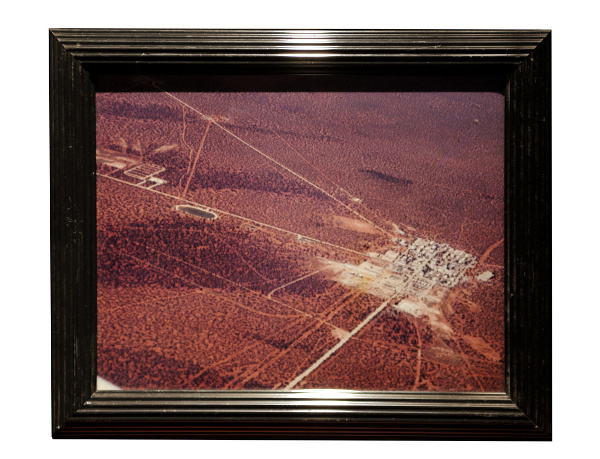
Figure 13) 'Maralinga' section: Aerial of Maralinga Village, 1961, South Australia. Reproduction from an original Kodakchrome colour slide. Digital inkjet print; 25 x 20 cm. Photo: Avon Hudson.
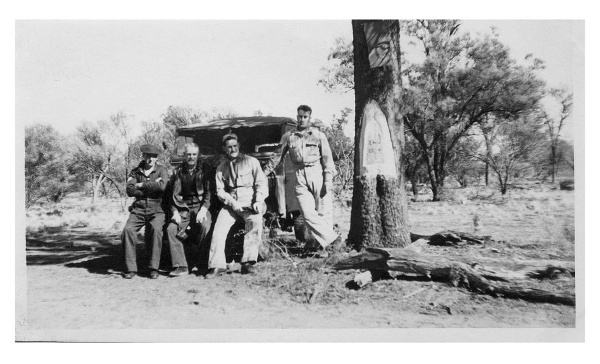
Figure 14) 'Maralinga' section: Road from Maralinga to Emu, 1961, South Australia. Reproduction from an original silver gelatin photograph. Digital inkjet print; 20 x 25 cm. Avon Hudson's private collection. The tree marks the 60-mile mark to Emu from Maralinga, which was the approximate halfway point. In the photo Avon is third from the left. On a spare day the men would go 'swanning'; Avon would take out British military and science personnel and show them around the bush- they would dig out scorpions in the sand hills, track snakes, and attract emus. Photo: Avon Hudson.
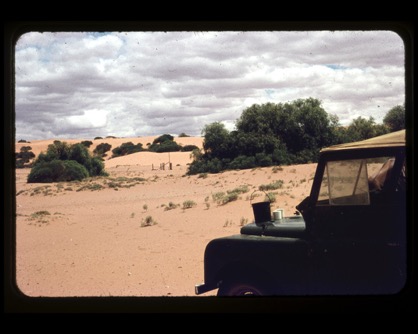
Figure 15) 'Maralinga' section: Tea Time, Ooldea Soak, near Maralinga, 1961, South Australia. Reproduction from an original Kodakchrome colour slide. Digital inkjet print; 25 x 20 cm. Photo: Avon Hudson.
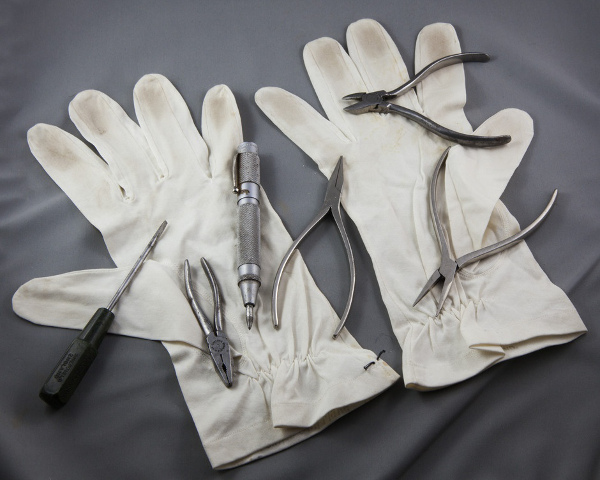
Figure 16) 'Maralinga' section: Scientists Gloves, 1961-2015, Digital inkjet print; 40 x 50 cm. After driving an electronic technician down to do some finishing touches on a device related to one of the Vixen B experiments prior to explosion, the technician asked Avon to hold his tools and silk gloves. They returned 7 km to the roadside station and waited for the device to be fired. The miniature tools - a collection of pliers, wire cutters, automatic center punch, and screw driver - were made in Sheffield, England, by the famous toolmakers at William Marples under the Shamrock brand. Avon never returned the tools, and the technician never asked for them back. Photo: the Author.
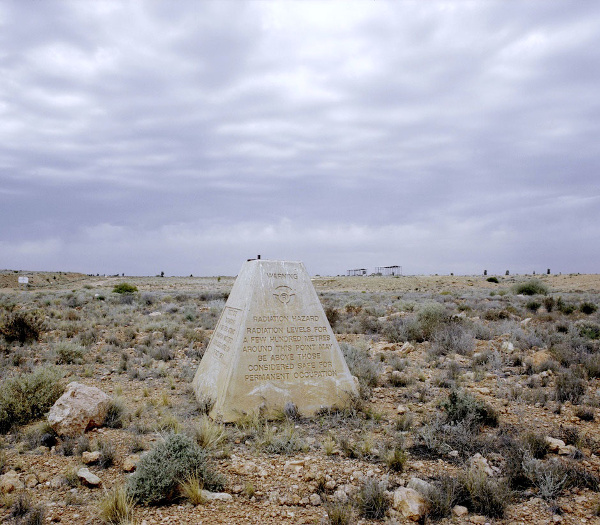
Figure 17) 'Maralinga' section: Taranaki Plinth, Maralinga, 2011, South Australia. Digital inkjet print; 80 x 70 cm. Ground zero site of the Taranaki bomb test, Maralinga, South Australia. Photo: the Author.
'Whistleblower, the Legacy'
As a veteran of the Minor Trials at Maralinga, Avon Hudson alerted the Australian public to the failed attempts to clean up the Maralinga nuclear bomb test site, when he took a media contingent to the site to show where radioactive debris had been buried in the 1970s. He is a leading public campaigner for nuclear veterans' rights, a writer, a woodcarver, and long serving contributor to the local community of Wakefield. Avon's actions helped install the Royal Commission into British Nuclear Tests in Australia in the mid 1980s. (Wall Text)
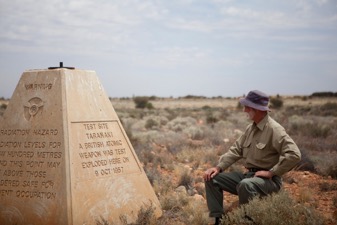
Figure 18) 'Whistleblower: the Legacy' section: Still from 'Maralinga Pieces' 2012. Film by the Author.
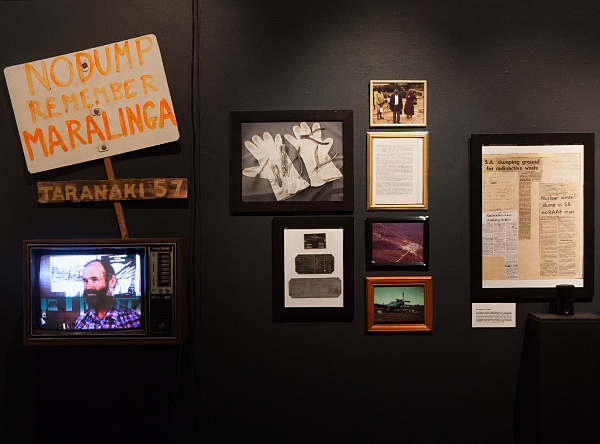
Figure 19) Portrait of a Whistleblower in Nuclear exhibition at Tandanya National Aboriginal Cultural Institute, Adelaide, South Australia, 2016. Photo: the Author.
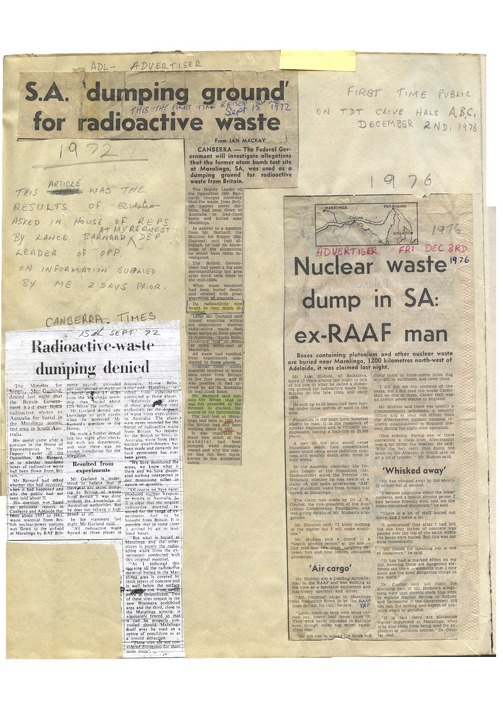
Figure 20) 'Whistleblower: the Legacy' section: Page from Avon's scrapbook 1972-1976. Reproduced from original document. Digital inkjet print; 50 x 70 cm. Avon Hudson's private collection. Photo: the Author.
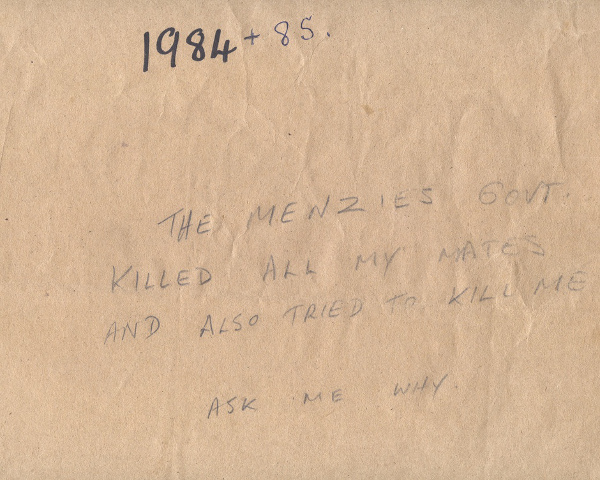
Figure 21) 'Whistleblower: the Legacy' section: 'Menzies killed all my mates, 1984-1985, Avon Hudson. Reproduced from original document. Digital inkjet print; 25 x 20 cm. Avon Hudson's private collection. This section of Avon's scrapbook cover refers to Australian Prime Minister Robert Menzies (1949-1966), who signed off on the British nuclear testing program in Australia. Photo: the Author.
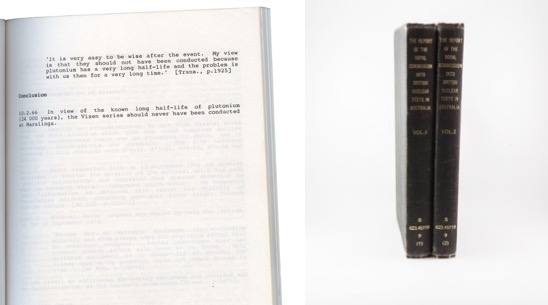
Figure 22) 'Whistleblower: the Legacy' section: Page 415 from the Royal Commission into British Nuclear Tests in Australia on the conclusion of the Vixen trials, 1985, South Australia. Reproduction of original document. Digital inkjet print; 18 x 18 cm. Avon Hudson's private collection. Photo: the Author.
Figure 23) 'Whistleblower: the Legacy' section: The Report of the Royal Commission into British Nuclear Tests in Australia, vol 1 and 2, 1984-1985. 2015, South Australia. Digital inkjet print; 25 x 20 cm. Photo: the Author.
'Advocate, Activist and Educator'
Over the years, Avon has helped many families who have been affected by the atomic bomb tests. He has a capacity to see the big picture and to provide support. He spent 25 years as a councilor in the Wakefield Regional Council and fought, among other things to make the area a nuclear-free zone. Avon has also participated in many Friends of the Earth Radioactive Exposure Tours that take people from all over the country and the world into South Australia's outback to learn about the nuclear industry. (Wall Text)
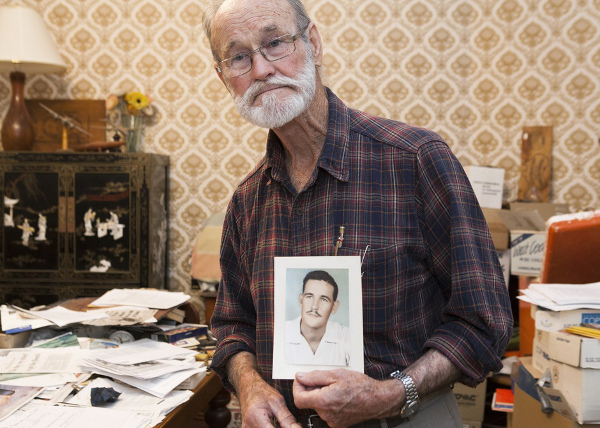
Figure 24) 'Advocate, Activist and Educator' section: Avon Hudson holding a photograph of himself from 1954, 2014, Balaklava, South Australia. Digital inkjet print; 70 x 50 cm. Photo: the Author.
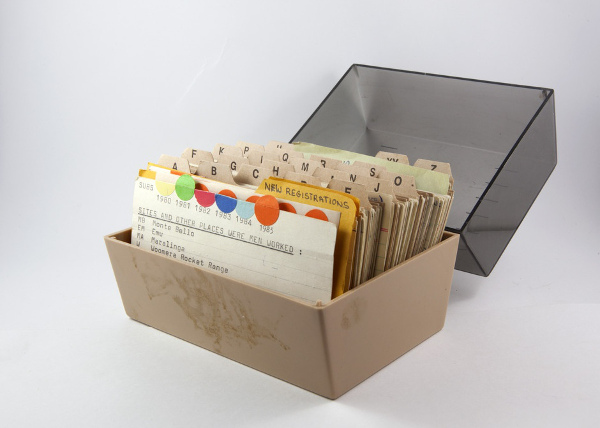
Figure 25) 'Advocate, Activist and Educator' section: Australian Nuclear Veteran Association (ANVA) Index Cards, 2015, Balaklava, South Australia. Digital inkjet print; 25 x 35 cm. The Australian Nuclear Veterans Association documented servicemen's posts and their illnesses associated with their work. Photo: the Author.
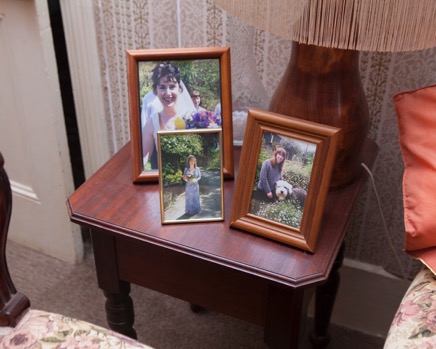
Figure 26) Photographs of Avon's family, 2014, The Author, Balaklava, South Australia. Digital inkjet print; 25 x 20 cm. This photo was taken in Avon Hudson's home in Balaklava, South Australia. The impacts on Avon's family as a result of his actions as a whistleblower were profound; many local community members in the town where they lived had shunned them, calling Avon a 'traitor' and a 'troublemaker'. Photo: the Author.
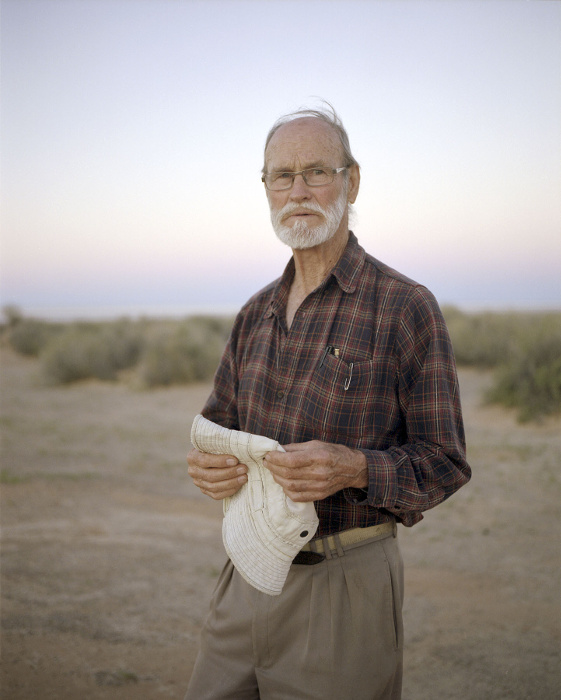
Figure 27) Portrait of a Whistleblower, 2014, Lake Eyre, South Australia. Digital inkjet print; 100 x 80 cm Photo: the Author.
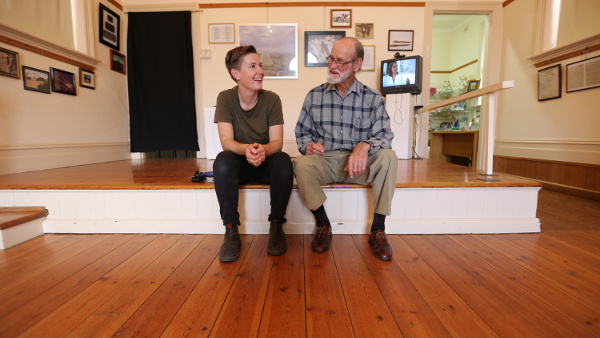
Figure 28) Jessie Boylan and Avon Hudson at Balaklava Courthouse Gallery February 2015. Photo: Tania Safi.
Footnotes
- Portrait of a Whistleblower was developed with support from the Australia Council for the Arts and Arts South Australia. Subsequent seasons in 2015-6 were presented at The Block (QUT, in Queensland) and Tandanya (National Aboriginal Cultural Institute) in South Australia. Co-curators are Jessie Boylan, Ellise Barkley, Avon Hudson and Paul Brown. ↩
- Part 2, section 9 of the Defence (Special Undertakings) Act 1952 states that "A person is guilty of an offence if the person [...] publishes or communicates to some other person a photograph, sketch, plan, model, article, note or other document or information relating to, or used in, an area, or relating to anything in [a prohibited] area...." of which the maximum penalty is imprisonment for 7 years. ↩
- Friends of the Earth have been running the 'Radioactive Exposure Tours' since the 1980s, with the first of the Roxby Blockades happening in 1983 and again in 1984. These blockades in the desert brought people from all over Australia to protest at the gates of the Olympic Dam uranium mine in South Australia and demand that it be shut down. ↩
- 'Inhabited' portrayed Aboriginal and non-Aboriginal survivors of and activists against Australia's nuclear industry (other people in this exhibition included Arabunna Elder Kevin Buzzacott and atomic test survivor Yami Lester). ↩
- The Author was an organiser for the Friends of the Earth's Radioactive Exposure Tours between 2005 and 2014, and attended the 2005, 2006, 2008, 2010, 2011 and 2014 tours. ↩
- "There are 3 categories of DVA health cards. They include Gold, White and Orange. Gold card - 'DVA health card - For all conditions'. A Gold card entitles the holder to DVA funding for services for all clinically necessary health care needs, and all health conditions, whether they are related to war service or not. The card holder may be a veteran or the widow/widower or dependent of a veteran. Only the person named on the card is covered. 'Veterans' health cards', Web, accessed 8th February, 2017. ↩

